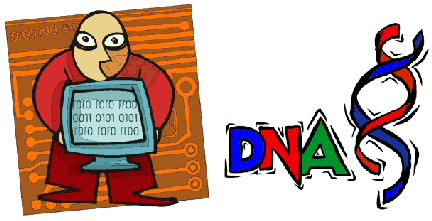 You are
learning much about the
process of evolution. You read and heard about types of organisms that
change over
time, what causes those changes, and in what ways various organisms
have
changed. You have probably developed a good understanding of the
significance of this information to evolutionary changes in life on
Earth. As we discuss the evidence further in your final web
assignment,
you will probably discover and would agree that the life on Earth
shares various similarities that are only explainable in the context of
evolution. But
would you include humans in that same group of "evolving life"?
The final activity in this series will address the issue of human
evolution. You are
learning much about the
process of evolution. You read and heard about types of organisms that
change over
time, what causes those changes, and in what ways various organisms
have
changed. You have probably developed a good understanding of the
significance of this information to evolutionary changes in life on
Earth. As we discuss the evidence further in your final web
assignment,
you will probably discover and would agree that the life on Earth
shares various similarities that are only explainable in the context of
evolution. But
would you include humans in that same group of "evolving life"?
The final activity in this series will address the issue of human
evolution.
Today's activity builds
on the work of
scientists participating in the HGP, or Human Genome Project. In
case you
are not familiar with this project, it began in 1990 as an
effort to
map each and every portion of the hum
Download a copy of "Genes, Variation, and Human History" from the National Human Genome Research Institute web site at http://www.genome.gov/19519278#mod2. Follow the instructions given with the program to install it on your computer.
As you work your way through the
program, be sure to write down your answer to each question. |
 an genetic
code. In addition to
mapping the human genome, the project also aimed to map the genetic
code of the
bacterium Eschericia coli, the yeast Saccharomyces
cerevisiae,
the roundworm Caenorhabditis elegans, the fruit fly Drosophila
melanogaster, the mouse Mus musculus, and several
additional
organisms. Currently, thegenomes of a number of species have
been fully decoded and many more are in the decoding process.
Scientists are using the information gathered from
the HGP and many similar ones to address human health issues as well as
to
investigate the origins of the human (and other) species. In this
activity, you will use an interactive program to investigate the
origin
and evolution of humans at a biochemical/genetic level. As you
work through
the program, be sure to remember the information that you studied
during
previous
assignments.
an genetic
code. In addition to
mapping the human genome, the project also aimed to map the genetic
code of the
bacterium Eschericia coli, the yeast Saccharomyces
cerevisiae,
the roundworm Caenorhabditis elegans, the fruit fly Drosophila
melanogaster, the mouse Mus musculus, and several
additional
organisms. Currently, thegenomes of a number of species have
been fully decoded and many more are in the decoding process.
Scientists are using the information gathered from
the HGP and many similar ones to address human health issues as well as
to
investigate the origins of the human (and other) species. In this
activity, you will use an interactive program to investigate the
origin
and evolution of humans at a biochemical/genetic level. As you
work through
the program, be sure to remember the information that you studied
during
previous
assignments.
